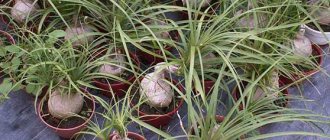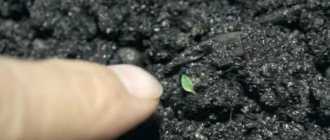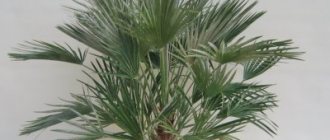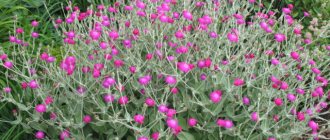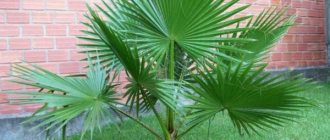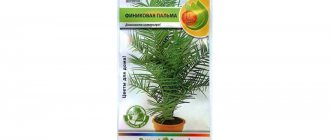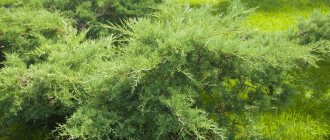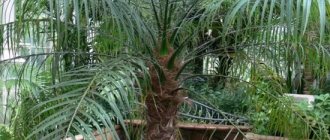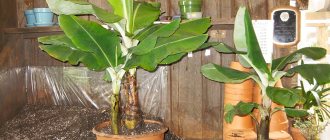Nolina, or bocarnea, is often grown as a showy houseplant. The most suitable type for this is nolina bent (Nolina recurvate), or bocarnea reflexum (Beaucarnea recurvate). The succulent is considered persistent and unpretentious. However, some mistakes in care lead to its death.
Nolina (Beaucarnea)
Bokarneya: care at home. Briefly
The big obstacles to growing tropical plants indoors are poor lighting and dry air. Bokarneya grows well at home. You just need to take into account that nolina also has its own preferences:
| Temperature | In the summer season – up to + 20°C, in winter – no higher than + 13°C. |
| Air humidity | Up to 50 %. |
| Lighting | Bright light, south or southeast window. |
| Watering | Rare but plentiful, the soil surface should dry out between waterings. |
| Soil for bocarnaia | Soil for succulents or a mixture of 2 doses of leaf soil, 1 dose of brick chips, 2 doses of clay, 1 dose of sand. |
| Feeding and fertilizer | In summer, once every 15 days, apply fertilizer to succulents. |
| Beaucarnea transplant | .Young bushes - in spring, once every 2.5 years; adults – once every 4.5 years; mature ones do not need to be replanted; only the top layer of the substrate is refreshed. |
| Reproduction | Seeds and apical cuttings. |
| Features of growing bokarneya | For better branching it requires mandatory pinching. |
In order for the plant to look impressive, the gardener must know the peculiarities of growing bocarnea. The tree requires careful care
You need to wipe the leaves carefully: they are very hard and sharp at the edges. When cracks appear on the nolina trunk, they are covered with garden pitch.
To give the plant a unique look, several specimens are planted in one pot at the same time. Planted close to each other, they gradually merge together, forming a powerful trunk. Trimming the tops at different levels allows you to form a stylish crown.
How to care for nolina in winter
Bocarnea, like most indoor plants, rests in winter. For proper rest, she needs cool air and dry soil, but leave the lighting bright. In order for the bottle palm to smoothly enter the dormant period, in November, begin to gradually lower the air temperature. For wintering, 10–16 degrees are optimal. Along with the cold weather, watering should be limited at first, and then completely stopped. During hibernation, bocarnea begins to consume nutrients and moisture from the caudex. Do not humidify the air in the room where the plant is located.
It is not always possible to ensure the side is cooler in winter. So try leaving it at normal temperature. But then you need to keep the watering regime close to the summer one, only a little less. Eliminate fertilizing. In this case, your bottle palm will not hibernate, but will seem to doze and slowly grow. To help with the scenery, be sure to turn on artificial lighting.
Diseases and pests
Proper care virtually eliminates the possibility of nolina being affected by any diseases. Its main enemies are spider mites, scale insects, scale insects and thrips. The presence of pests can be judged by the deformation, yellowing and death of leaves.
In this case, the first step is to mechanically remove the insects parasitizing the plant with a soap swab, and then treat the leaves with karbofos or actellik. Some gardeners are concerned about the gradual drying out and falling of the lower leaves, but if this does not happen to other leaves, then this is a natural process that does not require any measures.
Also, this should include the brown color of the tips of the leaves, which is the norm in tall trees, but if this is associated with an increase in temperature (over 20℃), you need to start spraying the plant.
If the trunk has acquired a dried out, wrinkled appearance, this indicates water loss during the wintering period, therefore, with the onset of spring, you need to begin gradually watering the plant.
Caring for nolina (bokarneya)
Lighting
This is a very light-loving plant. Give Nolina a well-lit place. Contrary to the generally accepted opinion that direct sunlight is not for her, I want to note that bocarnea easily tolerates them, but within reasonable limits. It is better not to place it near a south window without shading. But the south-east and south-west windows are just right, tested by personal experience. In winter, when the plant is resting, you can place it in partial shade.
Temperature
In the warm season, there is no upper temperature limit for this indoor plant. The higher the temperature, the better it is. Whenever possible, take the nolina out into the fresh air in the summer. She will be most comfortable there. During the winter dormant period, it is better to create cooler conditions for Nolina (optimally +10-15 degrees). To do this, just move it to the northern or western window sill.
Watering and air humidity
Succulents are easier in this regard. If you are used to regular watering, and then suddenly forget to water your bocarna, it will easily tolerate this. When watering all succulents, the main principle is to dry out the soil rather than flood it. In summer, water regularly, but only 2-3 days after the top layer of soil has dried. At normal room temperature, for an adult plant, this happens about once a week. In winter, watering is significantly reduced - no more than twice a month.
Nolina does not like dry air. The tips of its leaves dry out from the dry air.
Pay especially attention to this in winter, when the air is especially dry. Spray it regularly or create conditions of high humidity
This is the same nolina as in the top photo, but 3 years ago.
Feeding
Nolina can be fertilized only during the growing season, from spring to early autumn. Select fertilizers so that they contain more nitrogen. Fertilizers for decorative deciduous indoor plants are quite suitable. There is no need to feed bokarna often; once a month is enough.
Transfer
There is no need for frequent transplants. A cramped pot for nolina is preferable. Even if it seems to you that it is too small for her, do not rush to replant. This procedure is carried out approximately every three years. The soil for nolina is not particularly nutritious. You can use a cactus mixture by adding a little leafy soil.
What you especially need to pay attention to when transplanting bocarnea is good drainage. The water in the pot should not stagnate
Take a pot with large holes and make a good drainage layer of expanded clay, about one-fifth of the height of the pot.
Reproduction of nolina (bocarnea)
If you are lucky and Nolina gives birth to a baby, then this is the most reliable method of reproduction. But it cannot be called simple. It's all about the temperature required for the rooting of young nolina. The temperature of the soil in which it takes root should be no lower than +25 degrees. In some cases, you cannot do without bottom heating.
The second method of propagating nolina, which is gaining popularity, is by seeds. Since you will have to buy seeds, everything will depend on their quality. Before planting, they must be soaked in a stimulant solution (epin, heteroauxin, etc.) for 6-8 hours. After processing, the seeds are planted in a light peat mixture and covered with glass or film. The temperature should also be high enough. Then, as usual, ventilate and moisten the soil. When the seedlings grow up, they can be planted.
Pests
If the air is dry, then not only do the tips of the leaves dry out, but there is also a danger of spider mites appearing. Increase air humidity and treat the plant with an appropriate insecticide. The scale insect may also attack. It can be collected by hand, since the leaves of nolina are narrow. Then treat the leaves with Aktara solution and water it with the same solution.
Good luck with your growing!
Noticed an error in the text?
Reproduction
Propagation from seeds
For beginning gardeners, this is the best option to propagate Nolina. The seeds should be soaked in water for a couple of days. Then plant in a mixture of soil and perlite and cover with glass or film. It should not be planted deeply; the seeds germinate slowly. When you notice that the top layer has dried, sprinkle it with water, but do not water it.
In about a month, sprouts will appear; if you see a seed, do not touch it, as the sprout is still selecting all the beneficial substances from it. Only when the plants have grown and a small rosette of leaves has formed can the plants be planted in small pots with soil substrate for adult plants. Caring for them is no different from caring for an adult plant. Just check the substrate for moisture more often - in small containers it dries out faster and, therefore, requires more frequent watering.
Propagation by cuttings
In adult Bocarnea (Nolina), lateral processes are formed. From these you can prepare cuttings for propagation. Using a sharp knife, carefully separate the shoot. Before planting, you need to dry it a little, then in a greenhouse with a mixture of peat and perlite, use a pointed peg to make an appropriate depression and plant the cutting. Spray with water as needed. The appearance of new leaves will indicate that the cutting has taken root and is ready to be transplanted into a separate pot.
Care methods are close to natural
Ideally, conditions close to natural should be created for a houseplant. And take care of it the same way nature does. When caring for bocarney, you need to remember that it was born in a dry, hot climate. It is not spoiled by rains and fertile soils, which is why it acquired a thick caudex. And if you give bokara abundance - a lot of nutrition and moisture - she will not be happy, and most likely, she will get sick. The only thing you can’t go overboard with is light. So the main principle of care is moderation, close to stinginess.
Rules for watering and fertilizing
In the homeland of bocarney, rain is a rare guest. They happen once a month or less. The bottle tree has learned to wait out periods of long drought. And even after moving into an apartment, my habits did not change.
In spring and summer, when the plant is developing, water the nolina a lot, but not very often. The soil should dry completely between waterings and remain dehydrated for at least 3-4 days. For bocarnaia, dry soil is preferable to waterlogged soil. Irrigation water should be soft and settled. Ideal for rain.
Nolina is the center of the composition
In autumn, gradually reduce watering of nolina and lower the air temperature. In winter, when the air cools to plus 16 degrees, watering should be stopped completely. Nolina will easily survive drought thanks to its caudex. It decreases in size during dry wintering. But the combination of cool air and high humidity is dangerous for it. Sometimes it’s even fatal.
During the dry season, only occasionally wipe the leaves with a damp cloth. The procedure is needed not so much for moisturizing, but for the breathing of leaves.
If you decide to leave your bocarna without hibernation, that is, you have not lowered the temperature, you don’t have to stop watering. Just don't let it get too wet.
It is not recommended to feed Nolina often. Even during growth, in spring and summer, once a month is enough. Moreover, make the feeding solution twice as weak as what is written in the instructions. And alternate feeding: once - organic, the other - mineral. Any fertilizer for decorative leafy indoor plants is suitable. From November to March, feeding is stopped.
Watering
During the active growing season, the nolina flower must be watered systematically and abundantly.
The water that collects in the tray of the pot must be drained, since waterlogging of the soil can cause rotting of the root system of the plant.
The next watering should be done when the soil in the pot dries thoroughly.
In summer, the leaves of the plant should be wiped early in the morning with a soft, damp washcloth.
In winter, if the plant continues to grow, the leaves must be sprayed with soft or boiled water at room temperature. This is especially necessary if the room is heated from central heating radiators.
Spraying is best done in the morning.
Plant nutrition
The plant grows well without systematic feeding. A plant that is too large can be fertilized once a month with a weak solution of mineral fertilizers used for succulents.
Fertilizing must be done after watering so that the fertilizer is evenly distributed throughout the volume of the pot.
general information
An exotic tree from the asparagus family has adapted to growing in the rocky expanses of the arid plains of South America with sparse vegetation.
- It can go for long periods without rain, surviving thanks to the liquid accumulated in a bottle-shaped extension at the base of the stem - the caudex.
- The cork bark is mottled with wrinkled formations and resembles the rough skin of an old elephant, and its purpose is to prevent excessive evaporation of water.
- The structure of its leaves is such that it also delays the evaporation of water. You can even cut yourself on the edge of a long and hard sedge-like leaf. The leaves are the main decoration of bocarnea - shiny and rich green.
- Palm trees rarely bloom at home. Typically, flowering can be achieved in greenhouse conditions.
How to propagate Dioscorea Elephant's foot
The flower reproduces by seeds. In nature they ripen in the first months of autumn, at home - in spring. It is better to sow seeds in the fall, when the average room temperature is 15-20 degrees.
Young Dioscorea plants: 4 months after sowing seeds
Seeds are planted in a container with loose soil to a depth of 1-1.5 centimeters. The container is covered with a protective film and kept in a bright room. The planting needs to be moistened and ventilated regularly. Be prepared for the fact that the first shoots may appear in a month or two. After the first shoots appear, the film must be removed, the soil in the container should be kept moist, not allowing it to dry out. It is better to keep the container with seedlings in partial shade; bright sun is not very suitable for delicate seedlings. The seedlings grow quite slowly and only by the end of next summer can they grow to a state where they can be cropped in separate containers.
Description of the Nolina Bocarnea tree
In nature, the nolina tree grows up to 10 meters tall. Home decorative deciduous nolina is not so small. But with good care, you can grow an original home tree 2 meters high. In the trunk of the bocarnea, like in a reservoir, water accumulates, a supply of nutritional components. Another plus is that the leaves slowly evaporate the liquid. This is favorable and does not require a certain humidity where nolina grows. Nolina rarely blooms.
Varieties of nolina
According to official information, the genus includes 29 plant species, some of which are cultivated as ornamental ones. Cultivation of nolina is simple. Although the bush is not miniature, the root system does not grow to large sizes. The container for planting is selected low.
The following varieties are often found at home:
- Nolina is “thin”. The trunk is spherical at the base, the leaves are long, narrow, growing in bunches at the top of the tree. It blooms rarely; when it blooms, red flowers bloom on the tree.
- Nolina “sticking out” is similar to “thin”, with one difference - the leaves are hard, not hanging, but sticking up.
- Nolina is “bent”. On a massive trunk, narrowed at the top, a bunch of curly, arched, hard, long leaves were placed.
- Nolina "Lindermeira". The dark green leaves are thin and densely descending, hiding the trunk of the plant.
Nolina bocarnea flower
The tree practically does not bloom at home, just like the date palm. The color appears in the heat of summer and mainly in plants grown in greenhouses or in the open air. Small cream-colored flowers are united into a large inflorescence. During hot summers, the entire crown of nolina can be covered with flowers. When flowering, nolina emits a strong but pleasant aroma.
general description
The plant belongs to the agave family of succulents and is capable of accumulating large amounts of moisture for future use thanks to the trunk, which is strongly swollen in the lower part.
Moisture consumption is also controlled by the crown, formed from narrow belt-shaped leaves. In drought and extreme heat, the rosette shrinks into a bunch, further reducing the evaporating surface. In its homeland (USA and northern Mexico), under favorable conditions, it forms a tall tree, from the lower very thick bottle part of which several trunks grow, topped with picturesque flowing rosettes of leaves. In indoor conditions, you can grow a tree 0.5 m high in 5-6 years.
Branching usually occurs after flowering, which is extremely difficult to achieve at home. However, Dutch seedling growers achieve the desired branching by skillful pruning. This takes more than one season, so buying a finished copy is very expensive. More often, young seedlings with bulbous stem shoots go on sale.
The thickening of the trunk is called the caudex. Not only rare rainwater collects here, but also morning dew, which flows into the caudex along the grooved leaves.
Types of nolina with photos and names
Nolina longifolia
Also called longleaf bocarnea (Beaucarnea longifolia). In mid-latitudes, this species is most often grown in greenhouses, since it is almost impossible to create optimal conditions in an apartment. In the wild, this species is a tree with a strong trunk, the surface of which is covered with corky bark. Old leaf blades dry out and are observed to droop along the trunk, as a result they form something similar to a skirt. The large paniculate inflorescence consists of many creamy white flowers.
Nolina Lindheimeriana
Or Beaucarnea lindheimeriana. This plant has almost no trunk. Thin long sheet plates are distinguished by their strength. This type is also popularly called the “devil’s lace.” This type is the lowest compared to others. The composition of not very large paniculate inflorescences includes small flowers. This species is cultivated only in botanical gardens and greenhouses.
Nolina matapensis
Or Beaucarnea matapensis. Plants of this species are slightly taller than Lindemeyra nolina, but they are also short-growing, since their height does not exceed 200 cm. Dried old leaf plates droop, as a result of which something similar to a skirt is formed on the trunk. Large paniculate inflorescences consist of whitish-yellow flowers. This species cannot be cultivated at home.
Nolina recurvata
Or Beaucarnea recurvata. The shape of the trunk is bottle-shaped, expanding towards the base. Its height in wild conditions reaches 10 meters, and in domestic conditions it does not exceed 2 meters. At its top there are linear long narrow hanging leaf plates, which are collected into a rosette. The dark green foliage is about 100 cm long and approximately 20 mm wide; it feels leathery to the touch. Gradually, the lower part of the trunk becomes exposed. The foliage is used as a raw material in making baskets and sombreros. At home it hardly blooms. In the wild, a paniculate-shaped inflorescence consisting of cream flowers appears on the plant.
Nolina care
Nolina, bocarnea, ponytail, bottle tree - these are the names of one exotic plant. The flower belongs to the succulent family Agave. The description of nolina first appeared in 1803 thanks to the Frenchman Andre Michaud. The popularity of the flower is explained not only by its decorative appearance, but also by its exceptional unpretentiousness.
Nolina's homeland and appearance
The plant is native to Texas and northern Mexico. Nolina is perfectly adapted to survive in areas with very hot climates. A few rains are enough for the plant to accumulate a sufficient amount of moisture in the trunk. In hot weather, leaves gather in bunches and, thus, the evaporation of water from their surface is significantly reduced.
Nolina rightfully belongs to the most ornamental plants. The trunk is thick, greatly expanding towards the bottom. As a result, the shape of the barrel resembles a bottle.
The leaves are concentrated in the upper part of the plant, collected in bunches. The leaf blades are dense, leathery, fleshy, dark green in color. The length of each sheet can reach one meter.
Under natural conditions, the tree can reach a height of eight meters. As for flowering, it is impossible to see flowers in indoor conditions, since nolina can only bloom in natural conditions.
Nolina or bocarnea belongs to unpretentious plants. Considering the structural features of the trunk and the ability to accumulate water in it, nolina can not be watered for a long time. What the plant cannot tolerate is excess moisture. Excess water that gets into the soil does not evaporate, as a result the plant rots and dies.
It should be remembered that nolina grows slowly. It happens that for a long time the gardener does not notice any signs of plant growth, however, one should be patient. In order to speed up the growth process, it is enough to follow the recommendations of experts.
Watering mode
Compliance with the watering regime is an important condition for the successful cultivation of nolina. In spring and summer, the plant needs abundant but infrequent watering.
As a rule, the bottom watering method is used, when the flower pot is placed in a container of water. You can remove the flowerpot when the top layer of the substrate becomes shiny. After this, you need to wait for the excess moisture to drain and put the flowerpot in its usual place. The next watering can be done only after the soil is completely dry.
In autumn and winter, if there is no dormant period, the watering regime does not change; you can periodically spray the plant, preventing water from getting on the trunk.
At temperatures from +15 to +10 degrees, watering is reduced, and at lower temperatures it stops.
An adult plant can easily survive without watering for a year, using the water that has accumulated in the trunk.
Lighting requirements
Considering that in natural conditions nolina grows in bright light, it also needs to find the brightest place in the room. It is best to place the flowerpot on a south window. Otherwise, the plant trunk will bend, trying to reach the sun.
Temperature
In summer, the optimal temperature for nolina is from +20 to +25 degrees, and in autumn and winter the plant needs a dormant period. At this time, the temperature is reduced to +10 degrees.
In summer, in warm weather, you can take the plant out into the fresh air, but reliably protect it from drafts.
Top dressing
During the period of active growth, that is, in spring and summer, nolina is fed once every three weeks.
It is best to alternate mineral and organic fertilizers, and it is important to reduce the concentration of fertilizers by half compared to that indicated on the package
Nolina tolerates cactus fertilizers, manure and mullein well. During the replanting process, you can add ash to the soil.
Description of the Dioscorea plant
Plant classification
Scientific name: Dioscorea elephantipes Synonyms: Dioscorea elephantopus, Dioscorea montana, Dioscorea testudinaria, Rhizemys elephantipes, Rhizemys montana, Tamus elephantipes, Testudinaria elephantipes Common name: Dioscorea Elephant's foot Family: Dioscoreaceae (Dioscoreaceae) Genus: Dioscorea
The succulent Dioscorea Elephant's Foot is a flowering plant, one of 750 members of the genus Dioscorea. Among gardeners, due to its unusual appearance, the plant was called “turtle shell” or “Hottentot bread”. Note that the genus contains a large number of edible plants, thanks to which many African inhabitants receive nutrients.
Dioscorea in natural conditions can reach impressive sizes
The appearance of the flower deserves special attention. It has a large rounded tuberous stem, which in an adult plant under natural conditions can reach three meters in diameter and a meter in height. Part of the tuber is underground. The outer shell of the stem is covered with a hard shell-like shell, from which the plant received the name turtle shell, and inside contains pulp enriched with starch. When properly processed it is edible.
Thin, curly branches emerge from the upper part of the tuber, abundantly framed by foliage. The dark green leaves, about 3 cm long, are heart-shaped and have a glossy surface. The liana-like branches grow quite quickly and can reach five meters in length. Exotic blooms with small yellowish-green flowers with six small petals. The plant is dioecious - male and female flowers are on different plants. They are pollinated by insects.
A characteristic feature of the flower is that its dormant period (under natural conditions) begins in the summer. During the hot season, the foliage dies off and only with the arrival of cold weather the foliage and shoots sprout again. The flowering period occurs in the winter months. After flowering, seed pods are formed in which small-sized seeds ripen.
The root system of the plant is located in the upper layer of soil; it is quite small, which is why even a very large specimen can be easily removed from the ground.
Eyewitness impressions
The training center is located a few kilometers from Bolshoi Bunkovo. Entrance to the territory of the unit is only with passes. A bus takes visitors from the checkpoint to the garrison, because it is located three kilometers from the checkpoint. Soldiers spend about 3 months at the training center, then they are distributed. As eyewitnesses note, most often cadets of military unit 19889 end up in units of the Primorsky Territory.
Chevron of the 282nd Training Center for NBC Defense Troops
The soldiers live in a cubicle-type barracks. Once a month, funds are collected for the needs of the unit. Many military personnel note cases of theft of bank cards and mobile phones, but only due to the carelessness of the cadets themselves. Soldiers take the oath on Saturdays at 10:00 am. Parents are informed of the exact date by telephone. Also, soldiers must inform the unit commander about the number of relatives coming so that they can be issued passes.
This can be done at the checkpoint; in some cases, passes are sent by letter or issued on the spot. On the territory of the garrison there is a canteen, a medical unit and an ATM. Field exercises are carried out at the training ground, physical and drill training is carried out on the parade ground or in the sports complex. Chipok is located outside the unit’s territory and is visited by soldiers accompanied by officers.
Photo of the center's battle banner
After taking the oath, soldiers can use mobile phones only on Sundays. The rest of the time, phones are deposited with the unit commander. It is recommended to purchase Megafon SIM cards, because... There is no MTS tower in Bolshoi Bunkovo. Military personnel of military unit 19889 receive their allowances on a VTB-24 card; there is an ATM at the checkpoint of the training center. You can top up your card at a bank office or through online banking. In the first case, the sender pays a commission of 50 rubles, and in the second - 0.75% of the transfer amount. You can visit soldiers on Sunday; leave after the oath is granted on the security of the parents’ passport.
Celebration of Maslenitsa in part
Greenhouse and apartment types of bokarneya
In Northern Mexico you can see about 30 species of such trees. Only a few are brought to us. And in general, nolina in our country is considered both a rarity and an expensive house plant (if we talk about a one and a half meter giant in a pot, well, everyone can afford the seeds and recently planted “baby”).
Longifolia nolina (longifolia)
A powerful tree with a wide “cork” trunk.
In our country, such nolins are grown in greenhouses. There they can even bloom - profusely, with pink-cream flowers.
Matapskaya
Another option for greenhouses, growing up to 2 meters.
Blooms with white-yellow flowers.
The peculiarity of this species (as well as longifolia) is that if you do not cut off old, dried leaves, they will droop down, forming a “Hawaiian skirt” on the trunk of the plant.
Lindemeyer
Not the tallest species, but it also grows only in greenhouses (as well as in gardens in regions with warm winters).
The leaves are narrow, dry to the touch, but very dense. Because of this, Lindermeyer's bokarnea is called the "devil's rope."
Bent (recurvata)
Nolina "classical" shape.
Its leaves are very dense - it is from them that Mexicans weave their famous sombreros, as well as agricultural baskets. So by starting this plant, you will get a lot of raw materials for home crafts.
“In the wild” this tree grows up to 10 meters, in an apartment - up to 2 meters. The leaves are up to a meter long, although they are only 2 cm wide.
Popular view. The crown resembles a dandelion, with so many leaves sticking out of it in different directions.
Popular species for growing at home and in the garden
Nolina Parry (Beaucarnea, Nolina parryi)
One of the small types of bottle tree, only 1-1.5 meters high. The bluish-green leaves have finely toothed edges that reach 1-1.2 meters in length and only 2-4 cm in width. When the crown of the plant is deformed, several rosettes of leaves may form.
In the homeland of Bocarnea in Central America, the plant blooms with large racemes of white, yellow and pinkish small flowers. The flowers are tiny, but the blooms last a long time.
Plants of this species are quite cold-resistant and can grow in the southern regions in the open air.
Nolina Parry
Nolina Guatemala (Beaucarnea, Nolina guatemalensis)
Nolina Guatemala is also called “Guatemala tail” for its large number of long, narrow leaves. Sometimes there are species that have stripes along the edges of the leaves. Guatemalan Nolina is a tall plant, and like all specimens of this species, it accumulates the main moisture in the trunk. In adulthood, Nolina’s height reaches 5 meters, and the girth of the trunk is four meters.
Nolina Guatemala
Thin nolina (Beaucarnea, Nolina gracilis)
Whoever gave this name to this species of Nolina had a fair sense of humor. The fact is that its trunk looks like half a melon, with its blunt end sitting on the ground. The pattern of the trunk's bark resembles the shell of a large turtle. She is very loved by flower growers for her original appearance and easy care.
Nolina is thin
Nelson's Beaucarnea, Nolina nelsonii
Nelson's bokarneya is called beargrass or Nolina's blue in its homeland. This variety is surprisingly frost-resistant, withstanding frosts down to -10 degrees. In the southern regions of Russia it is planted as an exotic plant for landscaping. The bluish leaves completely cover the trunk and stick out in all directions very menacingly. By the way, the leaves have a serrated edge and can injure the hand of an unwary person.
Also read: Monilaria - bunny ears
Nelson's Beaucarney
Nolina bent - recurvata (Nolina recurvata)
This Bocarnea is popularly called the “elephant’s foot” or “bottle palm.” The plant's homeland is eastern Mexico. This species is now very well studied and cultivated. It is often found among amateur gardeners. In the wild it grows very tall with a spreading crown. But in indoor or greenhouse conditions, limited by the volume of the pot, it grows only about half a meter in height.
The plant looks very decorative at any age. And if your Nolina takes up too much space in the room, try to place her in a spacious office space, since caring for her is quite simple. But if the area of your house or estate allows Nolina to perfectly decorate the interior. In addition to the original bottle-shaped trunk, the plant is decorated with long leaves hanging from the apical rosettes. Sometimes they can be a little squirmy.
Nolina bent
Nolina, Bocarnea standard
A slow-growing variety, at first the trunk looks like a ball. Over time, the upper part stretches out and it becomes like a bottle. But the similarities don’t end there – the trunk accumulates moisture for a long time. The best Nolina for indoor growing. It grows slowly, making it convenient for beginning gardeners. It's the easiest to buy. You can order seeds online from a reputable company.
Bocarnea standard
Requirements for cultivation
Nolina adapts well to Russian apartments and feels good in various conditions. And yet she makes some demands on her owner.
This exotic plant loves lighting very much, so for its placement you can choose the south side and the hottest window. An adult plant can be difficult to place on a windowsill. In this case, it is necessary to place the tree as close to the window as possible. There is no need for shading; any bright light will only benefit this desert palm. If there is a lack of light, it will not disappear, but the external characteristics will decrease and the trunk will stretch towards the main light source. This problem can be prevented by rotating the pot.
For wintering, you will need to provide additional lighting by installing fluorescent lamps. It is advisable to reduce the temperature gradually to 10 degrees. Under such conditions, bocarnia will be able to prepare for winter and enter a resting state. Winter rest is not a prerequisite for its maintenance. You can do without this if it is not possible to create the necessary conditions for her rest.
Air humidity is completely unimportant for this crop from a hot climate. Even very dry air is not scary for her, she will feel great. In such conditions, it is advisable to wipe the leaves more often with a damp cloth, but not spray.
Young plants exhibit active growth and therefore need to frequently replace the pot. Usually you have to replant young nolina twice a year. An older plant does not grow so quickly and needs to be replanted about once every 5 years, maybe a little more often
You need to focus on matching the pot to the plant planted in it.
It is important to choose the right flower pot. The root system of an exotic palm tree does not go particularly deep, so the planting container should be flat with holes for water drainage
The plant looks most impressive in ceramic pots. Moreover, they are heavy and will not allow a large indoor flower to turn over.
Nolina loves loose soil, which is created from peat, sand and leaf soil. Peat and soil are taken in one part each, and sand needs two parts. You can add a small amount of pebbles to the substrate. The bottom of the pot must be filled with drainage material; it is best to use expanded clay, but other options are not prohibited. Then half of the prepared soil is filled in, the plant is installed and sprinkled on all sides with the rest of the planting mixture.
Growing nolina
Flower shops sell young nolina plants, several copies in a pot. Such plants cost much less than well-formed tall plants.
When grown indoors, the plant blooms very rarely. Nolina roots grow at a shallow depth to the side of the plant on the surface of the soil, so it is best to use low but wide pots for growing the flower.
In addition, high-quality drainage must be laid at the bottom of the pot, which must have a hole for the drainage of excess moisture.
Under natural conditions, the plant grows on rocky soils with a thin fertile layer.
Spread a thin layer of fine gravel on the surface of the soil or place several small stones, which will more clearly highlight the decorative properties of the plant.
Under natural conditions, the Nolina genus includes almost 30 species; the following types of plants are most often grown in indoor conditions.
Caring for bokarneya at home. Details
Home bokarnia is an unpretentious plant, but in order for its unique beauty to be fully revealed, you need to create optimal conditions.
Flowering nolina, bocarnea
Under natural conditions, only mature bocarnea blooms, forming many tiny light lilac flowers collected in panicles. Beautiful long inflorescences descend from the top of the tree, spreading a delicate aroma around.
Flowering of nolina and bocarnea at home is impossible. The plant only occasionally forms a peduncle, which is pinched to form a beautiful crown.
Temperature
To make the tree look attractive, it is necessary to maintain a certain temperature regime. In winter, the nolina plant should be kept at + 7 – 13°C. In summer, it is advisable that the thermometer does not rise above + 20°C.
Spraying
Bocarnea prefers average air humidity, so spraying is carried out only in hot weather with dry soil. They do this carefully, trying not to touch the trunk. Sometimes the foliage is wiped with a clean soft cloth.
Lighting
The tropical bocarney plant feels great at home in the southeastern and southern zones of the house. It is here that it will receive the bright lighting necessary for development. In less bright places, nolina will slow down, or even stop, its growth.
It is recommended to turn the tree with different sides to the sun to form a beautiful crown. When warm weather sets in in the spring, the plant is taken out into the fresh air. Place away from prevailing winds and drafts. The duration of daylight for normal development of bocarnea should be at least 10 hours. In winter, phytolamps are turned on.
Watering bocarneya
Excess moisture can destroy nolina. Enough time should pass between waterings so that the surface of the substrate has time to dry. Bokarneya is watered infrequently, but quite abundantly: in the summer - every 5 days, in the autumn and spring - after 12 days.
In winter, watering is stopped. The colder it is outside, the less often you should water. A clear sign of the need for watering is the shrinking and softening of the trunk. Use settled lukewarm water.
Nolina pot
The root system of the plant is located superficially, so nolina grows favorably at home and feels good in a low, wide container. Each new pot for nolina should be 2.5 cm larger than the previous one and stand steadily on a flat surface.
When determining the height of the pot, you need to understand that 1/3 of it is filled with drainage. There should be holes made at the bottom of the container for drainage. Mature plants are planted in tubs.
Soil for bocarnaia
Caring for bocarney at home requires planting the plant in a loose, breathable substrate. You can prepare your own soil for bocarnea from two parts of leaf soil and clay and one part of sand and brick chips. You can buy a soil mixture for succulents in the store and supplement it with charcoal powder and chopped sphagnum.
Feeding and fertilizer
When watering the bocarnea, combine feeding and fertilizing with a solution for succulents, diluted by half. The plant is fed only in summer, once every 14 days. After feeding, the plant is kept in the shade for 2 days.
Transfer
Young bushes are replanted once every 2.5 - 3 years, adults - once every 4.5 years, when they need a pot of a larger diameter. Mature plants that are more than 15 years old should be replanted only in extreme cases: when the root or trunk rots.
In other cases, they only refresh the top layer of soil. Bocarnea transplantation is carried out in the spring
This is done very carefully so as not to damage the roots and not to deepen the growing point. After transplantation, nolina can be watered after 4 days, and fed after 2.5 weeks.
How to prune bocarneya?
Plants are pruned to remove damaged parts or to give the crown a neat appearance. Nolina pruning is carried out irregularly, according to the decision of the grower. Each new “haircut” allows the tree to look neat and stylish.
Rest period
Bocarnea can grow tirelessly throughout the year, but rest is necessary for every living creature to prolong its existence and improve its health. A caring owner will artificially create a dormant period for the plant in winter, lowering the temperature to + 13°C, limiting watering and refusing stimulating fertilizing.
Transfer
Containers with several copies of seedlings usually go on sale. They require placement in separate containers. But there is no need to strive to transplant Nolina as quickly as possible after purchase. It should be replanted only after a week (at least) period of quarantine and adaptation to new conditions.
The roots require careful handling, so if possible, seedlings should be transferred by transshipment. After the plant is transplanted into a new container, a bag is put on it, leaving access to fresh air. It does not need to be removed until signs of leaf growth appear.
Domestic specimens require replanting approximately once every 3 years, but you should focus on the root system; by this time it should completely occupy the volume of the dish. An external sign of the need for housewarming is the cessation of leaf growth. The procedure remains the same.
Important! The thickened part must not be buried! The stem should remain in the ground at the same level.
Requirements for dishes
The roots of nolina, despite the arid conditions of wild growth, grow not in depth, but in breadth due to the shallow fertile layer of rocky soils. For this reason, she needs to select wide and fairly small bowls, paying special attention to their stability. Sometimes, for this purpose, several heavy stones are placed at the bottom of the pot, which additionally perform the drainage function that is extremely necessary for the plant.
When replanting older specimens, the diameter of the container is increased by 4 cm each time.
When transplanting, nolina is not watered! The plant is not able to absorb moisture in a state of adaptation; it will remain in the soil and lead to rotting of the roots.
Note to the florist
Why do nolina leaves dry out?
- The tips of the leaves dry out. The problem occurs if the plant is kept in a room with dry air. In such a situation, it is enough to spray the flower, but avoid getting water on the trunk. Otherwise, dark spots appear on the trunk and it rots. It can also be caused by insufficient watering or lack of nutrients in the soil.
- The leaves are withering. The reason lies in insufficient lighting. In summer, you need to choose the brightest window in the house, and in winter, use an additional source of lighting.
- The lower leaves dry out. This process is natural and should not cause concern.
- The trunk of the plant dries up. This occurs due to loss of moisture after wintering. The plant's normal appearance will be restored immediately after the normal watering regime is resumed.
Why is nolina growing slowly?
- Few new leaves are formed. The reason is lack of nutrients. Feeding the flower or replanting will help solve the problem.
- New leaves are small. This happens if nolina grows in a cramped pot, lacks lighting and is exposed to high temperature.

